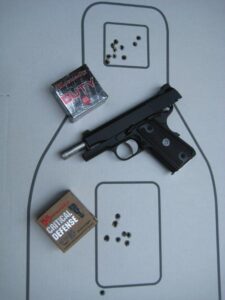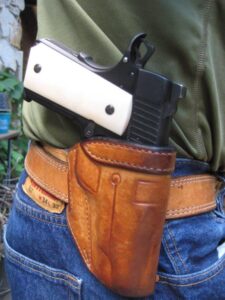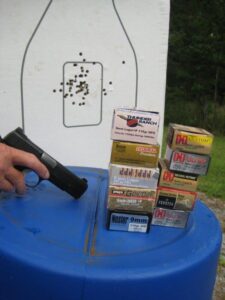
By John Markwell | Contributing Editor
I noticed a thread on one of the handgun forums a while back that got me to thinking about carry guns and how folks test them before they pronounce them good-to-go for self-defense and daily carry.
The procedures described by those responding to the question “how many rounds before you carry?” were diverse to say the least. Some shooters were not satisfied with handguns until they had fired 2000 consecutive trouble-free rounds. Others were satisfied with just a few magazines, or cylinders full, of cartridges. The obvious goal of testing the defensive handgun is to have 100% confidence that the gun will go bang when needed and continue to do so until the problem at hand is solved.
Firearms are nothing more than machines designed to launch projectiles and like all machines they are subject to wear and tear, parts breakage and dirt. However, most quality firearms are pretty durable so worrying about the odd breakdown is not what we are addressing here. The bottom line is the gun must function when needed; no alibis, no do-overs.
Over the last few years I have gone through the process of testing four different 1911 pistols. Each has now been carried concealed for defense of my self and loved ones should a situation arise. I have the ultimate confidence in all four guns and would bet my life on any of them.
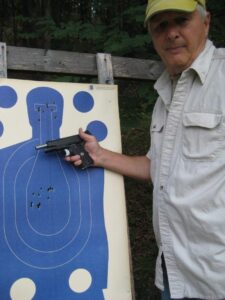
Before talking about the testing procedure I used in getting these 1911s the point that I would carry them, I’d like to address revolvers and striker fired pistols. Revolvers are about as reliable as a machine can be made to be. Over the years the only serious problems I’ve observed with defensive revolvers have been related to ammunition choices, short extractor rods that do not completely extract/eject empties (and stocks that hinder same), or people messing with springs to get a “better” double action trigger pull. Striker fired pistols, when used with factory magazines and ammunition, usually have few issues right out of the box if they are kept clean and properly lubricated. Some are ammunition sensitive and it may take some testing to sort out their likes and dislikes in the hollow point ammo realm. If you carry a revolver or striker fired polymer pistol, use and modify the guidelines below to achieve your carry confidence level for either.
As mentioned above, this story had its genesis with the question “how many rounds before you carry?” But, proving the reliability of a carry gun involves more that just shooting a bunch of rounds. Do the magazines for the pistol insert and eject easily and lock the slide back on the last shot? Does the gun consistently feed the first and last of your defensive rounds from all of its magazines? Is the trigger action consistent shot to shot? Do the safety features of the pistol all function reliably and smoothly? And does the gun shoot to the sights with the ammo you’ve chosen to stoke it with? Lastly, does the gun fire, extract, eject, and feed a fresh cartridge, without fail, every time you pull the trigger?
The first thing we do with a new 1911 (and most other handguns) is to totally strip the gun down and thoroughly clean and inspect it. You’d be surprised what you might find; metal chips, a burr in the firing pin channel, a sticky magazine catch and possibly a patch in the barrel. Usually there is nothing amiss but it doesn’t hurt to look and it gives one a chance to familiarize one’s self with the firearm; especially if it’s new to you. Upon re-assembly the weapon should be properly lubricated and all of the safety functions checked.
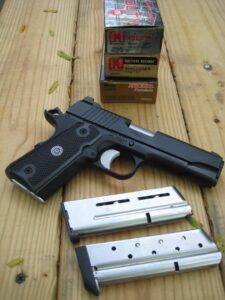
I guess the question that comes to mind when pondering this handgun reliability question is, in a similar vein, how many brake failures would you tolerate in your car or truck? The answer is up to you. The guns I carry daily are as reliable as the brakes on my truck. The thought of either not working when needed never crosses my mind. Is your defensive handgun as reliable as your vehicle’s brakes? If not, why not? Bear in mind that reliability testing of the defensive handgun is a bit more involved than stomping on the brake pedal.
I’ll use just one gun as an example. Several years ago I received a Guncrafter Industries 1911 CCO in 9mm for testing. After an initial inspection, disassembly and lubrication upon re- assembly, I took my electric pencil and marked each of the magazines dedicated to the gun with an etched number (1 through 4) and headed for the range.
First, I loaded one round in each magazine, loaded each round from slide lock and fired each with the gun going back to slide lock on each magazine. So far so good. If an autoloading pistol is going to have feed issues they are often either the first (top) or last (bottom) rounds in the magazine; at least that’s been our experience.
Next, we fully loaded all four magazines and inserted each in the pistol with the slide locked back. Tripping the slide release loaded the top round form each magazine into the chamber. We did this a few times giving each magazine a couple or three opportunities to feed the first round in the magazine. Remember how the last few rounds loaded into the magazine require more effort to insert than the first few? If they are harder to load into the mag they are harder to strip out upon feeding; the increased force required to feed the top rounds from a magazine often give some pistols trouble and this test will find that problem.
If the first round doesn’t feed, a slightly stouter recoil spring may be needed but this may lead to a failure to lock back on the round fired, so that test needs to be run again These magazine tests also should give one an idea if one’s defensive ammunition of choice is compatible with the chosen pistol. We’ve seen some guns feed anything and everything and others with a functional preference for just one load/bullet profile.
Although shooting a fair amount the carry ammunition of choice should be the final test of function, these mag tests can sort out some ammo without the expense of shooting up ammo that costs over a $1 per round. These simple tests also should give one an indication of any magazines that insert with difficulty, do not lock the slide back on the last shot, and do not eject freely when empty. Our last magazine test is to load each of the fully loaded magazines into the pistol with the slide in battery as if topping off the gun during an engagement. Some magazines when fully loaded are almost impossible to seat in the gun if the slide is in battery; some 10 round 9mm 1911 magazines being the worst in our experience.
The Guncrafter Industries 1911 CCO in 9mm passed all of the above tests with flying colors when initially tested several years ago. Since then it has not missed a single beat having fired several thousand rounds of both factory and handloaded ammunition. Should the manufacturer of your pistol of choice (Dan Wesson or Ed Brown) have a break-in recommendation, this procedure should put you well on your way to completing that.
Let’s end by going back to the original question at hand of how many rounds do you fire before you carry and depend on your new blaster to defend life, limb and loved ones? With the current availability and cost of ammunition, that is a difficult question that only the owner of a new carry gun can answer. I can tell you that in the event of a defensive encounter the last thing that should be on one’s mind is will the gun/ammo combo perform. The final decision is yours and you will have to live with the results of that.

